How Much Does Software Testing Cost in 2025?
Mobile apps have become indispensable tools for everyday tasks, thus presenting endless opportunities for businesses and startups. However, amidst the excitement of development, a critical stage often gets overlooked – the testing phase. With users increasingly reliant on mobile apps for everything from productivity to entertainment, delivering a flawless user experience is non-negotiable.
Yet, achieving this level of perfection requires a strategic approach to software testing. From functional testing to user experience assessments and translation accuracy, every aspect of the testing process comes with its price tag. So, in this article, we will try to answer the question: How much does software testing cost?
We can help you drive global growth, better accessibility and better product quality at every level.
The journey of mobile app development before launch
Bringing a mobile app from concept to launch is a complex journey that involves numerous steps, each with its unique set of guidelines and challenges and, consequently, varying costs for the work involved. Outlined below are the critical phases a mobile app undergoes before it hits the market and the estimated budget for each phase:
1. Identifying needs and gathering requirements (10-15%)
2. Crafting the algorithm, creating wireframes, and developing prototypes (10-15%)
3. The coding or development phase (40-50%)
4. Testing the app and ensuring quality assurance (15-25%)
5. Deploying and after-launch activities, including marketing, advertising, sales, and ongoing maintenance (10-20%)
These phases also influence the expenses tied to app testing. So, let's try to get an estimated cost in more detail below.
Understanding the costs of software testing and effective budgeting strategies
Software testing expenses typically account for 15 to 25% of the total project budget, adhering to industry norms. Insights from a 2019 survey highlight that, on average, 23% of an organization's annual IT spending is dedicated to quality assurance and testing. The rationale is straightforward: when your product successfully clears all quality assessments, it significantly increases the likelihood of customer satisfaction.
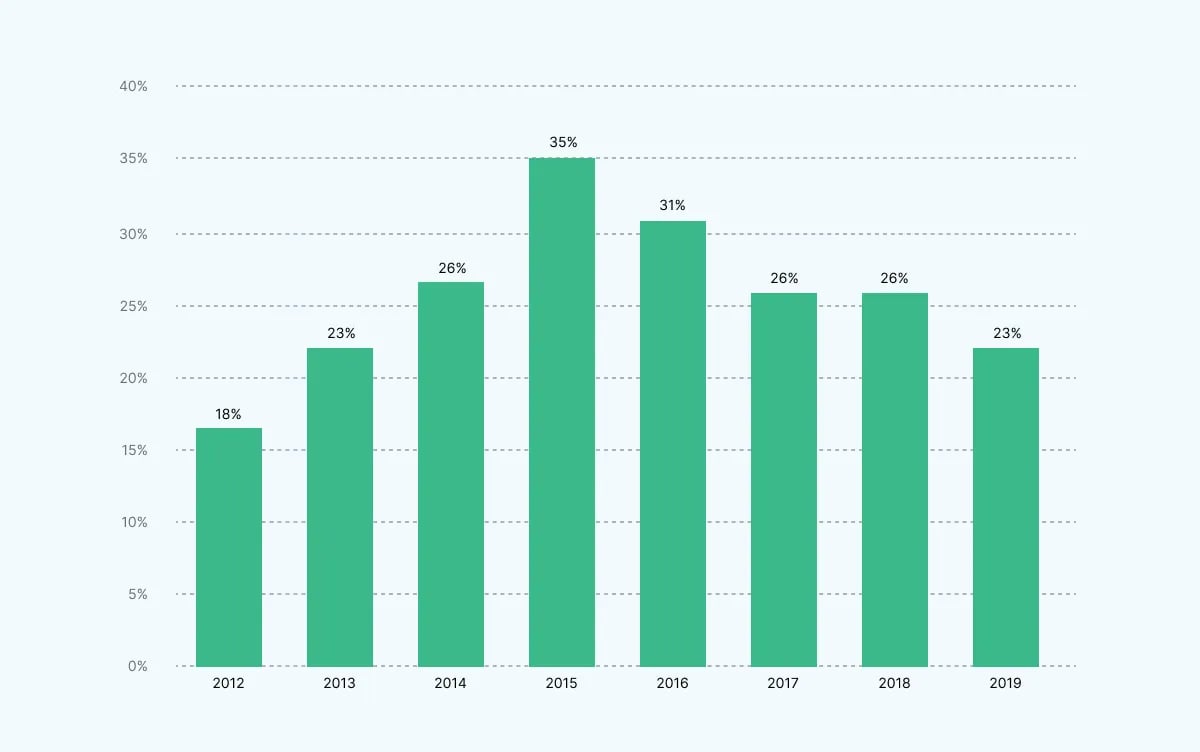
Determining the necessary team size and associated costs for testing your software product depends on various factors. For new applications, a standard ratio is one tester for every five to six developers, provided these developers handle unit and integration testing effectively. The required number of testers may fluctuate for modifications to existing applications based on the app's intricacy.
For mobile app testing, a small-sized app typically requires a team of 2 to 5 testers, while medium-sized apps may need 5 to 10 testers. This range can vary with the application's nature (such as web, mobile, or desktop apps), complexity, the testing scope, and the extent of developer testing.
To calculate hourly rates on average for testing roles, consider checking Indeed, Upwork, or similar sites to get a rough idea of the cost. Still, remember that the more complex your application is, the more hours you can expect to spend on quality assurance and problem-solving, which increases the total cost. Also, keep in mind other factors like the experience of testers, their geographical location, the urgency of the project, etc.
Software testing cost: 4 main categories
We can categorize software testing costs into four primary areas:
1. Prevention costs: These are investments made upfront to prevent defects from occurring in the software. Prevention costs typically involve training developers to write maintainable and testable code or hiring developers who already possess these skills.
2. Detection costs: Expenses related to developing test cases and setting up environments for defect detection. This includes creating and executing test cases, as well as setting up testing environments to simulate real-world scenarios. Detection costs are essential for uncovering issues early on, enabling teams to address them before they escalate into more significant problems.
3. Internal failure costs: Costs incurred in rectifying defects before product delivery. They include the resources and efforts required to remedy defects, such as debugging, reworking code, and conducting additional testing. Addressing defects internally helps prevent their impact on the end-user experience but still comes with associated expenses.
4. External failure costs: Expenses for addressing technical issues that arise post-delivery due to compromised product quality. These costs can be substantial, including customer support, warranty claims, product recalls, and reputation damage. 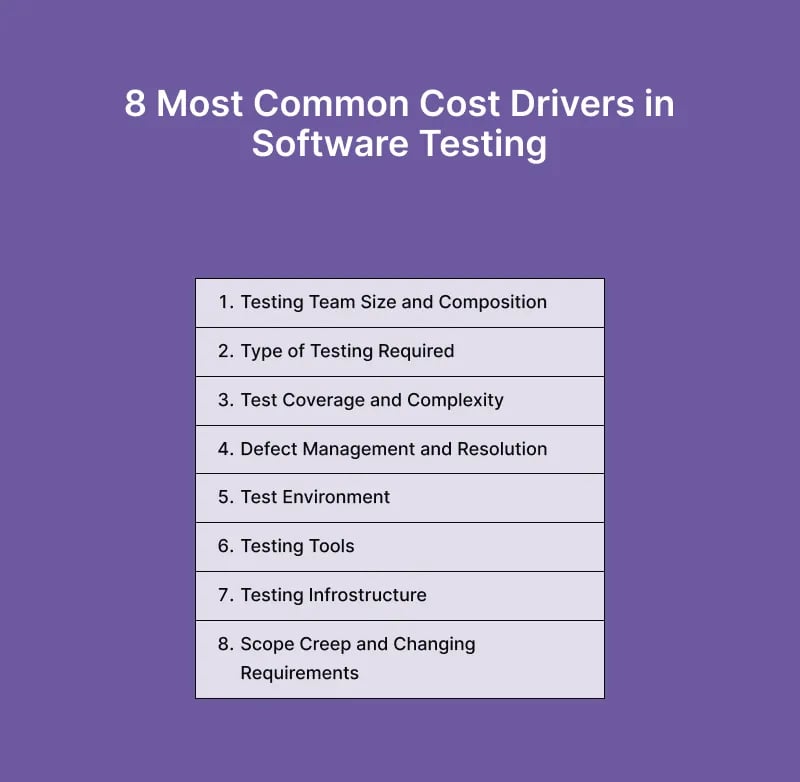
Detection costs often represent a significant portion of testing expenses, even if no defects are identified. Addressing defects before product delivery is crucial for saving time and money and preserving your business's reputation. Notably, the cost associated with external failures is generally lower than the combined costs of internal failures and defect detection.
So, it's advisable to carefully plan and evaluate testing activities based on these cost categories so your testing team can develop a robust testing strategy, ensuring confidence and quality in the final product.
Elements that elevate testing expenses
Even if you have your budget planned out, there is a high probability of unexpected costs that can add up:
- Code revision: When errors are discovered during testing, it often necessitates revising the affected code sections. This revision process can extend the development timeline as developers address and rectify issues, increasing the overall testing budget.
- System recovery: System failures encountered during testing or due to software bugs can lead to significant expenditures in terms of both recovery time and resources. This includes efforts to restore system functionality, troubleshoot problems, and minimize downtime, all of which contribute to higher testing expenses.
- Error resolution costs: Identifying and rectifying bugs involves costs associated with determining the most effective corrective strategies. This process may require skilled resources, extensive testing, and iterative problem-solving, all of which add to the overall testing budget.
- Data re-entry: Correcting data inaccuracies identified during testing often requires re-entering data, which is both costly and labor-intensive. This task consumes valuable resources and time, contributing to higher testing expenses.
- Operational downtime: System failures and errors can impact operational efficiency, leading to downtime that incurs additional costs for troubleshooting and fixes. The longer the system remains non-operational, the greater the financial impact on the organization, including lost productivity and potential revenue.
- Strategic analysis sessions: Resources and time allocated to strategic analysis meetings and discussions contribute to overall testing expenses. These sessions are crucial for evaluating testing strategies, identifying areas for improvement, and making informed decisions. Still, they also incur personnel, time, and resources costs.
- Error tracing: Challenges in identifying the root cause of software issues can prolong testing efforts and inflate costs. This includes efforts to trace errors back to their source, investigate dependencies, and implement effective solutions, all requiring additional resources and time.
- Iterative testing: Ensuring that bug fixes haven't introduced new issues often requires multiple rounds of testing, known as iterative testing. Each iteration adds to the testing timeline and budget as testers verify the effectiveness of the fixes and ensure overall system stability, contributing to higher testing expenses.
8 strategies to minimize software testing expenses
Now, let's move to the equally important part – how to cut expenses.
1. Early and frequent testing
Numerous studies show that rectifying an error after product release can cost 4 to 5 times more than during the design phase and up to 100 times more during maintenance. Implement early testing from the unit to integration testing phases, focus on high-priority issues like performance and security, and integrate regression and continuous testing in agile sprints.
2. Implement Test-Driven Development (TDD)
TDD involves writing tests before the actual code. This practice enhances code quality, reduces bugs, and ensures full test coverage from the outset. Start by defining precise project requirements and test case scenarios, then create unit tests for expected outcomes. This leads to improved code structure and easier feature additions.
3. Employ a hyper-testing strategy
In Agile projects, adopt a hyper-testing approach that looks at processes, practices, and tools to address testing challenges. This comprehensive strategy enhances the speed to market, reduces test maintenance costs, and boosts continuous testing capabilities.
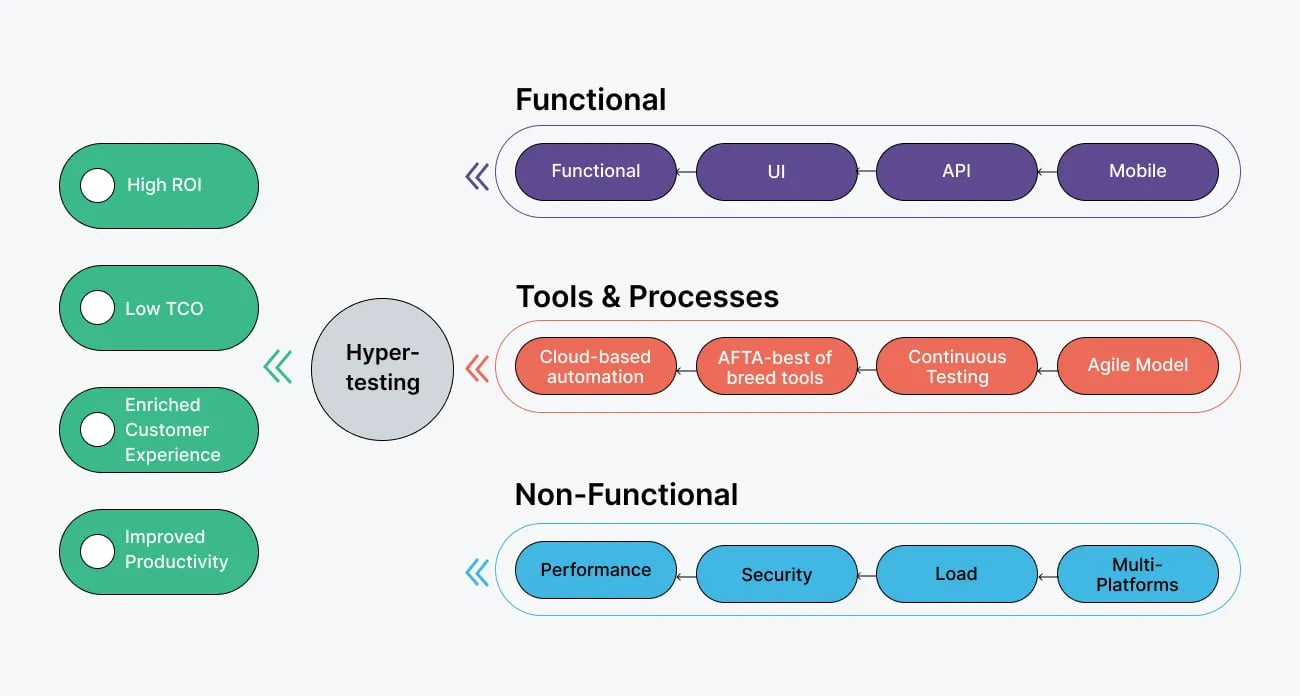
4. Leverage modern tools for UI testing
Automate UI testing with tools that offer quick and codeless visual regression testing. These tools provide smart image comparison and DOM structure analysis and facilitate user acceptance testing, thereby saving time and resources and improving collaboration among team members.
5. Adopt risk-based testing
Prioritize testing based on potential risks, focusing on the likelihood of failure and its impact. This approach helps specify test cases, identify security and performance issues early, and align testing efforts to mitigate risks effectively.
6. Utilize reusable training materials
For new testers, use existing resources and recorded materials for training instead of creating new ones every time. This approach reduces the time and cost of onboarding new QA team members.
7. Account for hidden costs
Be aware of unforeseen expenses related to the need for specific testing tools, learning new methodologies, and infrastructure costs for automated testing. Keeping an eye on these can help you manage your budget more effectively.
8. Consider outsourcing
If you don't have trained personnel, skill, time, or resources for adequate in-house testing, the next best thing is to outsource testing. However, many services or vendors offer a tiered model based on hourly, per-project, or fixed-price systems. The model you choose should be aligned with the duration and nature of the task to ensure financial feasibility.
At Global App Testing, we pride ourselves on a testing approach with global reach in more than 190 countries and 90,000 testers. Given the diversity of our testing pool, we are available 24/7, whether you need rapid testing within 60 minutes or a full-on approach from start to finish.
Comparing manual and automation testing: Which offers better cost-efficiency?
Determining the cost-effectiveness between manual and automation testing hinges on understanding their distinctions. Manual testing relies on human resources, necessitating investment in skilled testers. Conversely, automation testing demands investment in tools and frameworks for automation.
Manual testing involves meticulous step-by-step exploration of features, which can be both time-intensive and costly. In contrast, automation testing is known for its swiftness and lower expenses.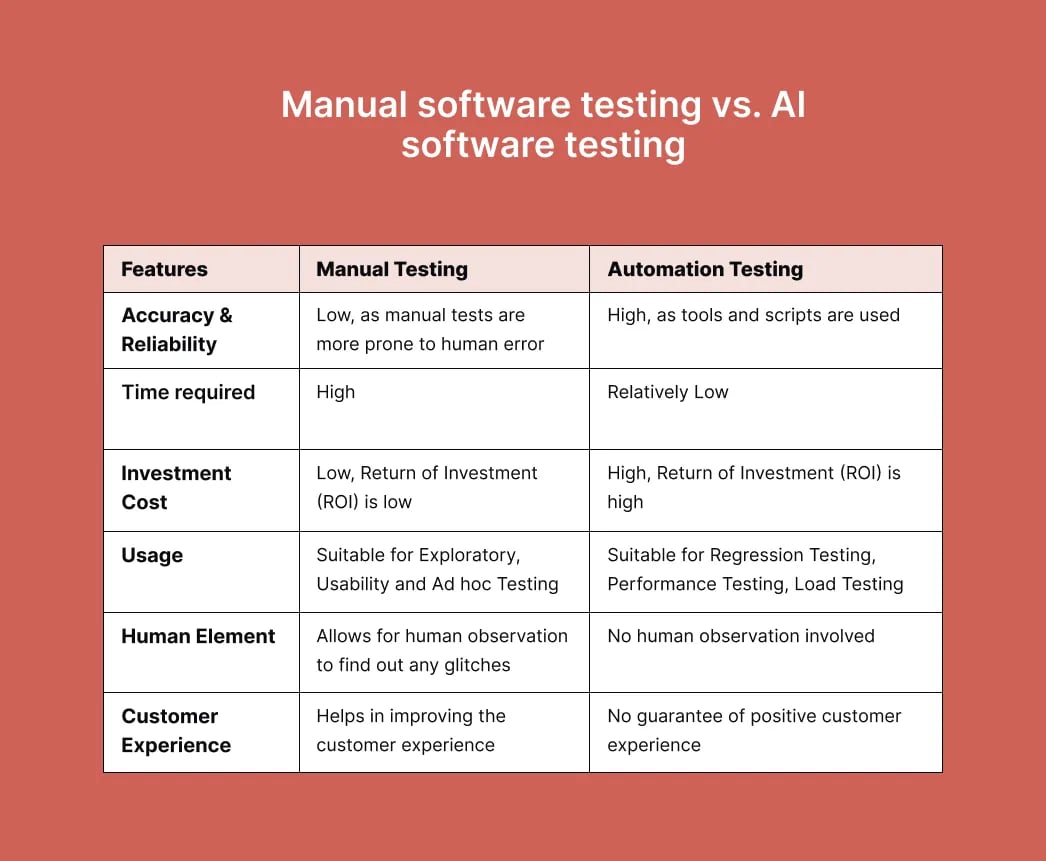
Yet, both methodologies play crucial roles in software testing, each contributing to delivering high-quality software to users. Therefore, a balanced approach utilizing both manual and automation testing is essential. At GAT, we offer a blend of both for maximum cost and quality efficiency.
How much does software testing actually cost – An example
Let's take a hypothetical software project and see what kind of testing you need for each step:
1. Identifying testing requirements
Testing requirements for a web-based e-commerce platform may include functional testing of features like user registration, product search, shopping cart functionality, checkout process, and payment processing. Non-functional testing requirements may include performance testing to ensure the website can handle peak traffic loads and security testing to protect user data.
2. Breaking down testing activities
Break down testing activities into phases such as:
- Test planning (creating a test plan, defining test objectives)
- Test design (writing test cases, preparing test data)
- Test execution (running test cases, logging defects)
- Defect management (tracking and prioritizing defects, retesting fixes)
- Test closure (analyzing test results, generating test reports).
3. Estimating time required
Based on experience, you can estimate that functional testing of the e-commerce platform will take approximately 4 weeks, with an additional 2 weeks for non-functional testing. Break down the time estimate further by allocating 1 week for test planning, 2 weeks for test design, 4 weeks for test execution, 1 week for defect management, and 1 week for test closure.
4. Determinating resource costs
Calculate the cost of personnel involved in testing, including salaries and benefits. For example, if the testing team consists of 5 members (testers, test leads, and automation engineers) with an average monthly salary of $5,000 each, the monthly cost would be $25,000. Additionally, estimate the cost of testing tools and infrastructure, such as $10,000 for testing software licenses and $5,000 for cloud hosting services or outsourcing costs.
5. Considering testing environment
If you do in-house testing, estimate the cost of setting up a testing environment for the e-commerce platform, including purchasing virtual machines for different operating systems, mobile devices for cross-device testing, and network infrastructure (for performance testing). Factors in ongoing maintenance costs for the testing environment include software updates and hardware upgrades. Or, if you opt for GAT services, you can access more than 60k devices, ensuring unmatched testing coverage.
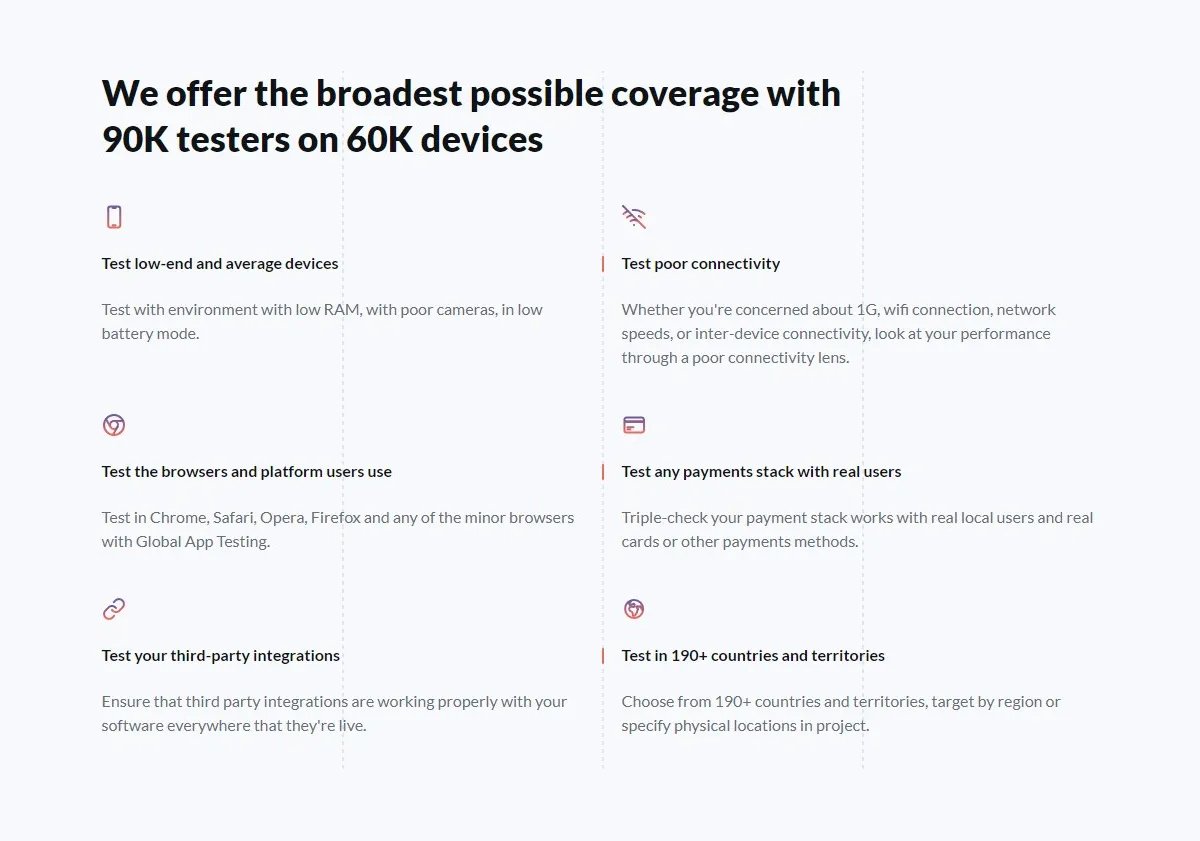
6. Including contingency
Allocate a contingency budget of 15% of the total testing cost to cover unexpected events or changes in project scope. This contingency reserve can address delays in testing, additional testing requirements identified during the project, or unforeseen technical challenges.
7. Reviewing and adjusting
Regularly review the progress of testing activities against the planned schedule and budget. Identify any deviations or risks that may impact the project timeline or cost. Adjust the cost estimates accordingly by reallocating resources, revising the testing plan, or updating the contingency budget as needed to ensure the successful completion of the project within constraints.
Conclusion
The conversation surrounding software testing costs can seem never-ending until you have precise project requirements and a defined scope. Once you've settled on the technology stack and determined the project scope, the next step is to delve into estimating software testing costs. During this phase, you'll need to explore your options, such as outsourcing the testing or hiring in-house developers. It's essential to carefully consider what's covered and what's not in each scenario.
At Global App Testing, we offer comprehensive testing solutions that include benchmarking against competitors, detailed analysis, and QA consultancy services. We aim to ensure that your product is free of bugs, user-friendly, secure, and ready for widespread adoption and enjoyment. Schedule your consultation now and elevate your product's quality assurance game!
We can help you drive localization as a key initiative aligned to your business goals
Keep learning
10 Mobile app testing best practices
7 beta testing tools to consider in 2025
How to write a test strategy document for your testing

